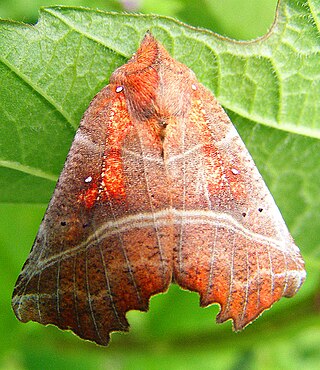
The Noctuidae, commonly known as owlet moths, cutworms or armyworms, are a family of moths. They are considered the most controversial family in the superfamily Noctuoidea because many of the clades are constantly changing, along with the other families of the Noctuoidea. It was considered the largest family in Lepidoptera for a long time, but after regrouping Lymantriinae, Catocalinae and Calpinae within the family Erebidae, the latter holds this title now. Currently, Noctuidae is the second largest family in Noctuoidea, with about 1,089 genera and 11,772 species. This classification is still contingent, as more changes continue to appear between Noctuidae and Erebidae.

Noctuoidea is the superfamily of noctuid or "owlet" moths, and has more than 70,000 described species, the largest number of any Lepidopteran superfamily. Its classification has not yet reached a satisfactory or stable state. Since the end of the 20th century, increasing availability of molecular phylogenetic data for this hugely successful radiation has led to several competing proposals for a taxonomic arrangement that correctly represents the relationships between the major lineages.

The genus Calyptra is a group of moths in subfamily Calpinae of the family Erebidae. They are a member of the Calpini tribe, whose precise circumscription is uncertain but which includes a number of other fruit-piercing or eye-frequenting genera currently classified in Calpinae.

The Catocalinae are a subfamily of noctuoid moths, placed in family Noctuidae. In the alternative arrangement, where the Noctuidae are reduced to the core group around the Noctuinae, the present lineage is abolished, the upranked Catocalini being merged with the Erebini and becoming a subfamily of the reestablished family Erebidae.

The Ophiusini are a tribe of moths in the family Erebidae.

Amphipyrinae is a subfamily of owlet moths in the family Noctuidae. There are more than 50 genera and 210 described species in Amphipyrinae, although the classifications are likely to change over time.

The Calpini are a tribe of fruit-piercing moths in the family Erebidae; formerly they were included in the family Noctuidae. The proboscis of the adult moths of this tribe is pointed and barbed, allowing the moth to pierce the skin of fruit to drink the juice. The vampire moths in the genus Calyptra can pierce mammal skin to drink blood.

Baniana is a genus of moths of the family Erebidae. The genus was previously classified in the subfamily Calpinae of the family Noctuidae.

Isogona is a genus of moths of the family Erebidae. The genus was erected by Achille Guenée in 1852.

Homodes is a genus of moths of the family Erebidae first described by Achille Guenée in 1852.

The Erebidae are a family of moths in the superfamily Noctuoidea. The family is among the largest families of moths by species count and contains a wide variety of well-known macromoth groups. The family includes the underwings (Catocala); litter moths (Herminiinae); tiger, lichen, and wasp moths (Arctiinae); tussock moths (Lymantriinae), including the arctic woolly bear moth ; fruit-piercing moths ; micronoctuoid moths (Micronoctuini); snout moths (Hypeninae); and zales, though many of these common names can also refer to moths outside the Erebidae. Some of the erebid moths are called owlets.
Calyptra bicolor is a moth of the family Erebidae. It is found in India. It has been known to feed on humans, as well as a variety of other mammals.
Calyptra eustrigata is a moth of the family Erebidae, found in Sri Lanka and Malaysia. It has been reported as exhibiting parasitic blood-sucking behavior.
Calyptra fasciata is a moth of the family Erebidae. It is found in India. It has been known to feed on humans, as well as a variety of other mammals.

Calyptra minuticornis, the vampire moth, is a moth of the family Erebidae. It has been found in Indonesia, Java, India, Sri Lanka, and Australasia.
Calyptra ophideroides is a moth of the family Erebidae. It is found in East Indies. It has been known to feed on humans, as well as a variety of other mammals.
Calyptra pseudobicolor is a moth of the family Erebidae. It is found in India. It has been known to feed on humans, as well as a variety of other mammals.
Calyptra parva is a moth of the family Erebidae. It is found in India. It has been known to feed on humans, as well as a variety of other mammals.

The Scoliopteryginae are a subfamily of moths in the family Erebidae. Larvae have distinctive, extra setae on the first through seventh abdominal segments. Many adult moths in the subfamily have a proboscis adapted to pierce fruit skin, allowing consumption of the juice in the fruit.













